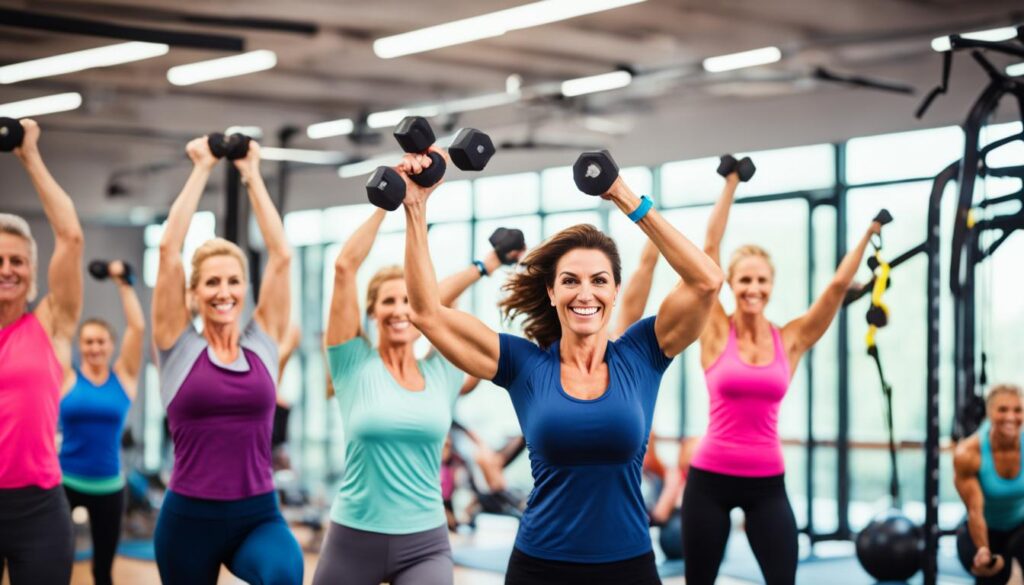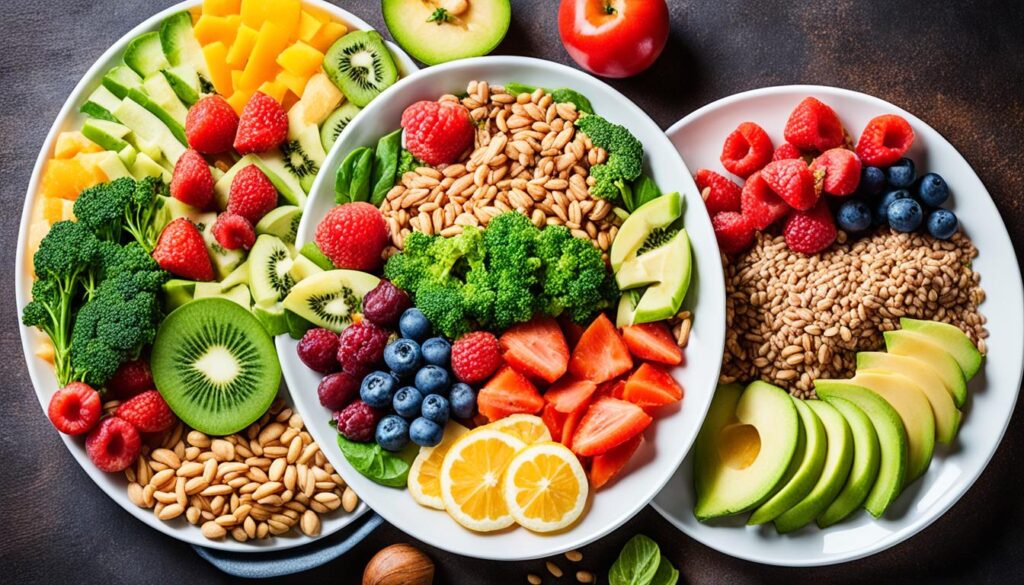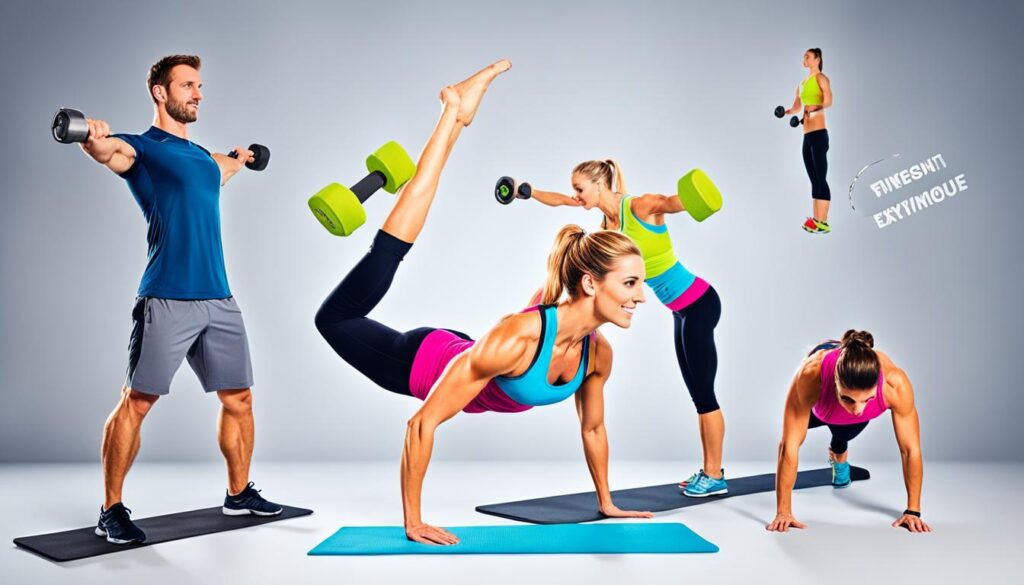Did you know 80% of Americans don’t meet the recommended exercise levels? This is a big issue, given how much exercise can do for you. Whether you want to build muscle, lose weight, or get fitter, the key is finding the right workout plan for you.
This guide will cover various workout routines to help you find the best one for your needs. We’ll look at strength training, cardio, flexibility, and sport-specific programs. This way, you can make smart choices for your fitness path.
Key Takeaways
- Understand your fitness goals and set realistic objectives to achieve the desired results.
- Discover the benefits of strength training, cardio, and flexibility routines for different body transformations.
- Explore sport-specific training programs and home workout options to fit your lifestyle.
- Learn about proper warm-up, cool-down, and recovery strategies to prevent injuries.
- Develop a nutrition and supplementation plan to support your workout regimen.
Understanding Your Fitness Goals
Before starting your fitness journey, it’s key to know what you want to achieve. Whether it’s to build muscle, lose weight, or boost your health, matching your workouts with your goals is crucial for success.
Setting Realistic Objectives
It’s vital to set goals that are realistic and achievable. Don’t aim too high, or you might get discouraged. Create a plan that fits your needs and abilities.
- Break down your long-term goals into smaller, measurable milestones.
- Set time-bound objectives that you can track and adjust as needed.
- Consult with a fitness professional or health expert to help you establish realistic goals.
Identifying Your Priorities
After knowing your fitness goals, figure out what’s most important to you. This way, you can use your time and resources wisely. Focus on what matters most.
| Priority | Focus Area | Example Exercises |
|---|---|---|
| Muscle Building | Strength Training | Weightlifting, Resistance Training |
| Weight Loss | Cardio | HIIT, Steady-State Cardio |
| Flexibility and Mobility | Stretching and Yoga | Yoga, Pilates, Dynamic Stretching |
Knowing your fitness goals and priorities helps you create a workout plan that suits you. Remember, being consistent and patient is important. Stick to your plan and celebrate your progress.
Strength Training for Muscle Building
If you want to build muscle and get stronger, you need a good strength training plan. This type of training is key for muscle growth because it makes your muscles work hard against resistance. We’ll cover the main ideas of strength training to help you make a plan that works for all your muscle groups and your goals.
Compound Exercises for Maximum Gains
To really build muscle, focus on exercises that work many muscles at once. Compound exercises like squats, deadlifts, bench presses, and pull-ups work a lot of muscles. These exercises should be the base of your routine because they let you lift heavy and make your body adapt and grow.
Progressive Overload: The Key to Continuous Muscle Growth
Progressive overload means making your workouts harder over time. You can do this by lifting heavier weights, doing more reps, or doing more exercises. This keeps your muscles challenged and helps them grow. Remember, strength training is not the same for everyone – pay attention to your body and change your plan as needed.
Proper Form: The Foundation of Strength and Muscle Building
It’s very important to do your strength training exercises right to grow muscle and avoid getting hurt. Focus on how you do the exercise, not just how much weight you lift. Get help from trainers or coaches to make sure you’re doing each exercise correctly and hitting the right muscles.
| Exercise | Muscle Groups Targeted | Benefits |
|---|---|---|
| Barbell Squat | Quadriceps, Glutes, Hamstrings | Builds lower body strength and muscle building |
| Deadlift | Back, Hamstrings, Glutes | Develops muscular strength and power |
| Bench Press | Chest, Shoulders, Triceps | Enhances upper body muscle building |
Being consistent and patient is important when you’re trying to build muscle with strength training. By following these tips, you’ll be on your way to reaching your muscle-building goals.
Cardio Workouts for Weight Loss
Reaching your weight loss goals needs a balanced approach. Cardio workouts are key in this journey. Two main types of cardio stand out: high-intensity interval training (HIIT) and steady-state cardio. Each has its own benefits and fits different fitness levels and preferences.
High-Intensity Interval Training (HIIT)
HIIT workouts are famous for burning fat and boosting heart health. They mix intense exercise with rest periods. This pattern keeps your heart rate up, helping you burn calories even after you stop working out. HIIT is great because it’s quick, effective, and fits easily into your schedule.
Steady-State Cardio
Steady-state cardio means working out at a steady, moderate pace for a longer time. Activities like walking, jogging, or cycling are good examples. This type of cardio burns calories steadily and builds endurance. It’s a great addition to HIIT workouts, helping you burn more calories and recover between intense sessions.
When planning your workout for weight loss, mix HIIT and steady-state cardio. Together, these methods offer a complete approach to losing weight. They help you burn fat, increase endurance, and support a healthy lifestyle.
“Consistent cardio exercise is key to successful weight loss. Combining HIIT and steady-state workouts can help you maximize your results and keep your body guessing.”
| HIIT Cardio | Steady-State Cardio |
|---|---|
|
|
Flexibility and Mobility Routines
Keeping up with flexibility and mobility is key for staying healthy, avoiding injuries, and doing your best. We’ll look into why these exercises matter. We’ll see how yoga can help you move better and boost your fitness.
Yoga for Flexibility
Yoga is a great way to get more flexibility and mobility. It uses poses, stretches, and breathing to make your muscles longer and stronger. This helps you move better and feel more flexible.
Doing yoga often brings many benefits, like:
- More flexibility in muscles like the hamstrings, hips, and back
- Better joint movement, which helps in other activities too
- Good posture and body awareness, which lowers injury risk
- Less muscle tightness and pain, especially in stiff areas
- Feeling more mobile and easy in your movements
Adding yoga to your workout can open up new levels of flexibility and mobility. This can lead to better health and performance.
| Yoga Pose | Primary Benefits |
|---|---|
| Forward Fold (Uttanasana) | Stretches the hamstrings, calves, and lower back |
| Pigeon Pose (Eka Pada Rajakapotasana) | Targets the hips and opens the front of the thigh |
| Cobra Pose (Bhujangasana) | Improves flexibility in the spine and shoulders |
Putting flexibility and mobility first in your workouts can boost your physical skills. It also helps your overall health and lowers injury risk. Yoga is a great way to reach these goals and fully use your body’s movement.
different workout routines for different results
Reaching your fitness goals is not the same for everyone. It’s important to know that different workouts lead to different results. Whether you want to build muscle, lose weight, or get healthier, picking the right exercises is key.
Strength training is great for adding lean muscle. It involves exercises that work many muscles at once. This can help you grow muscle and increase your metabolism. For losing weight, cardio workouts like HIIT or steady-state cardio are better.
Yoga and flexibility exercises improve how well you move and lower injury risks. They also make you feel balanced and mindful. If you’re into sports, training that focuses on your sport can help you perform better.
Finding the right fitness transformation comes from choosing the right workout routines for your goals. Knowing what you need and like helps you make a plan that works for you.
| Workout Routine | Primary Goal | Potential Results |
|---|---|---|
| Strength Training | Muscle Building | Increased muscle mass, improved strength, enhanced metabolism |
| Cardio (HIIT, Steady-State) | Weight Loss | Fat loss, improved cardiovascular health, increased endurance |
| Flexibility and Mobility (Yoga) | Improved Range of Motion | Enhanced flexibility, reduced injury risk, better balance and coordination |
| Sport-Specific Training | Athletic Performance | Increased sport-specific skills, improved endurance, better overall conditioning |
Remember, the secret to a great fitness transformation is trying different workouts to see what works for you. With hard work and sticking to it, you can reach your health and wellness goals.
Full-Body Workout Routines
Full-body workout routines are a great way to get fit. They work out many muscle groups at once. This helps with strength, endurance, and balanced fitness. These workouts make your training efficient and lead to better results.
Circuit Training
Circuit training is a favorite for many. It’s a high-energy workout that mixes exercises targeting different muscles. You do these exercises in a set order with little rest. This keeps your heart rate up and builds strength and endurance.
Here are the perks of circuit training:
- Time-efficient: You get a full workout in less time by doing several exercises together.
- Increased calorie burn: The constant movement helps you burn calories during and after your workout.
- Improved muscular endurance: Doing exercises without much rest makes your muscles stronger and more resilient.
- Versatility: You can adjust circuit training to fit your fitness level, goals, and what equipment you have. It’s a flexible workout option.
Adding full-body workouts and circuit training to your routine can change your fitness game. They work out many muscles at once. This leads to efficient and balanced results while keeping your workouts fun and interesting.

“The beauty of full-body workouts is that they work your entire body, which leads to greater overall strength and muscle development.”
Sport-Specific Training Programs
For athletes or sports enthusiasts, sport-specific training is key to better performance and injury prevention. These programs focus on the skills, strength, and endurance needed for your sport. They make sure you’re ready to perform at your best.
Whether you’re a serious runner, a weekend basketball player, or a weightlifter, adding sport-specific training to your routine can boost your performance. By knowing what your sport requires, you can create a training plan that targets the right muscle groups and movements. This helps you succeed in your sport.
Enhancing Sport-Specific Fitness
Sport-specific training includes several key elements:
- Skill-Based Drills: These are exercises that focus on the basic skills of your sport, like dribbling in basketball or sprinting in track and field.
- Strength Training: This builds the muscles and movements crucial for your sport, such as explosive power for weightlifters or endurance for runners.
- Conditioning Workouts: These improve your heart and metabolism for your sport, whether it’s intense intervals for soccer or steady-state training for cyclists.
- Flexibility and Mobility: These improve your movement and joint flexibility to enhance performance and lower injury risk.
By combining these elements in a well-planned program, you can reach your full athletic potential. This approach helps you improve your athletic performance significantly.
Tailoring Your Training
Effective sport-specific training means understanding your sport’s unique demands. A good way to do this is by working with a coach or fitness for athletes expert. They can help you understand what your sport needs and create a training plan just for you.
The sport-specific training method is not a one-size-fits-all approach. Every athlete and sport is different. It’s important to customize your training to fit your needs. By doing so, you can improve your athletic performance and achieve more success in your sport.
Home Workout Options
In today’s fast-paced world, not everyone can go to the gym often. But, you don’t have to give up on fitness. Home workouts, especially bodyweight exercises, are a great way to stay fit from home.
Bodyweight Exercises
Bodyweight exercises are a great choice for those who don’t need special equipment. They use your own weight as resistance. This helps build strength, endurance, and improves your overall fitness.
These exercises are very versatile. You can do push-ups, squats, burpees, and lunges that work different muscles. They offer a full workout and can be adjusted for any fitness level.
Bodyweight exercises are also very convenient. You can fit them into your daily routine, whether it’s in the morning or evening. You don’t need gym memberships, equipment, or a way to get there. Just your body and the motivation to move.

To start with home workouts, make a routine with exercises for your upper body, lower body, and core. Start at a level you’re comfortable with and slowly increase the intensity as you get stronger.
Home workouts, especially bodyweight exercises, let you stay fit and healthy without a traditional gym. They’re convenient and effective. Try them out and see how they can change your life.
Recovering and Preventing Injuries
Keeping up with your workout plan is key to reaching your fitness goals. But, don’t forget about recovery and injury prevention. Using the right warm-up and cool-down exercises, along with recovery techniques, helps your body adjust to workouts. This reduces the risk of injuries that could stop your progress.
Proper Warm-up and Cool-down
A good warm-up and cool-down routine is vital for recovery and injury prevention. Warm-ups get your muscles, joints, and heart ready for exercise. Cool-downs help your body slowly come back to rest, aiding in recovery.
Start with 5-10 minutes of light cardio, like brisk walking or jogging, before your workout. Then, do dynamic stretches for the main muscle groups you’ll use. This boosts blood flow, warms you up, and makes you more flexible, lowering the chance of muscle injuries.
After your workout, spend 5-10 minutes cooling down. Include light cardio, static stretches, and foam rolling to lessen muscle soreness and boost flexibility. Proper warm-ups and cool-downs improve workout recovery and lower injury prevention risks.
Additional Recovery Techniques
- Hydration: Drink lots of water before, during, and after workouts to stay hydrated and aid recovery.
- Active Recovery: Do light, easy activities like walking or gentle yoga on rest days to keep blood flowing and help muscles recover.
- Foam Rolling: Roll on a foam roller to ease muscle tension, reduce soreness, and improve movement.
- Sleep: Get 7-9 hours of good sleep each night for deep repair and recovery.
- Nutrition: Eat a balanced diet with protein, carbs, and healthy fats to help muscles repair and support your body.
Focus on workout recovery and injury prevention for better training, faster recovery, and reaching your fitness goals. Remember, taking care of your body is as crucial as your workouts.
“Proper recovery and injury prevention are key for a successful workout routine. By focusing on these, you can push harder, train more often, and see better results over time.”
Nutrition and Supplementation
Reaching your fitness goals is not just about exercise. It also needs a good nutrition and supplementation plan. This part will show you how to feed your body right for your fitness aims. Whether you want to build muscle, lose weight, or boost your health and performance.
Good nutrition is key to getting the most from your workouts. Eating a balanced diet full of protein, carbohydrates, and healthy fats helps with muscle building, energy, and recovery. Adding smart supplementation can also help fill nutritional gaps and give you an extra edge in fitness.
Macronutrients and Calorie Needs
Figuring out your best macronutrient and calorie intake depends on your activity level, body type, and fitness goals. A good rule of thumb is to aim for these macronutrient ratios:
- Protein: 20-30% of total daily calories
- Carbohydrates: 40-60% of total daily calories
- Fats: 20-30% of total daily calories
Adjusting your calorie intake based on your goals, like muscle building or weight loss, can enhance your workout results.
Supplementation for Fitness Nutrition
Along with a balanced diet, supplementation can boost your fitness nutrition. Popular supplements for those into fitness include:
- Protein powders (whey, casein, or plant-based)
- Creatine for muscle power and endurance
- BCAAs for muscle recovery
- Pre-workout formulas for energy and focus
- Fish oil or omega-3 for less inflammation
When picking supplements, make sure to look for reputable brands, talk to a healthcare expert, and stick to the recommended amounts.

By mixing a well-thought-out nutrition plan with smart supplementation, you can fuel your body and support your fitness goals. This leads to better results and a lasting fitness journey.
Staying Motivated and Consistent
Staying motivated and consistent is key for a successful fitness journey. Consistency builds progress, and motivation keeps you going. By using strategies to boost your motivation and track progress, you’ll reach your fitness goals.
Tracking Progress
Keeping an eye on your progress is vital. You can measure your body, track workouts, or see how your clothes fit. Using a fitness tracker, journaling, or taking photos helps show your progress. Celebrating small wins keeps you motivated and inspired.
Remember, progress isn’t always straight forward. Setbacks happen, but staying aware of your progress helps. Adjusting your approach keeps you positive and leads to lasting results.
FAQ
What are the different types of workout routines available?
There are many workout routines for different fitness goals. You can find routines for building muscle, losing weight, or improving flexibility. Each type targets specific goals to help you get fit.
How do I set realistic fitness goals?
First, check where you are in your fitness journey. Then, think about what you want to achieve. Set goals that are realistic and match your desired outcomes. This makes planning your workouts easier and tracks your progress.
What are the benefits of strength training for muscle building?
Strength training helps build muscle and boost strength. It focuses on compound exercises, increasing weight over time, and proper form. This approach works all major muscle groups for muscle growth.
How can I use cardio workouts for weight loss?
Use high-intensity interval training (HIIT) and steady-state cardio for weight loss. HIIT burns fat fast, while steady-state cardio boosts endurance and burns calories.
What are the benefits of flexibility and mobility exercises?
Flexibility and mobility exercises keep you healthy, prevent injuries, and improve performance. Yoga is great for increasing flexibility and fitness.
How can I create a full-body workout routine?
Try circuit training for a full-body workout. It targets many muscle groups in one session. This method helps you get fit overall and supports your fitness goals.
Why is sport-specific training important for athletes?
Sport-specific training prepares athletes for their sports. It builds the skills, strength, and endurance needed. This approach boosts performance and lowers injury risk.
What are the benefits of home workout options?
Home workouts, especially bodyweight exercises, are convenient. They let you exercise at home without a gym membership. These workouts are effective and easy to do for those without gym access.
How can I prevent injuries during my workouts?
Warm up and cool down properly to prevent injuries. These exercises help your body adjust to your workouts. Adding them to your routine lowers injury risk and supports your fitness goals.
How do nutrition and supplementation support my fitness goals?
Good nutrition and supplements are key for fitness goals. The right foods and supplements support muscle building, weight loss, and overall health.
What strategies can help me stay motivated and consistent with my workouts?
Stay motivated by tracking progress, setting realistic goals, and building good habits. These strategies help you stay on track and reach your fitness goals.


